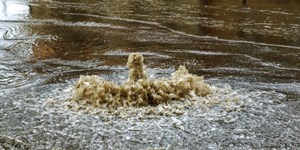Leaking wastewater systems named top source of San Diego River contamination, study finds
(UI) — A five-year study by the Southern California Coastal Water Research Project (SCCWRP) has identified deteriorating wastewater infrastructure as the primary source of human fecal contamination in the San Diego River.
Spills, leaks, and underground seepage from public sanitary sewer systems contribute over 90% of the total human fecal pollution in the river's urbanized watershed, according to the report.
The study, mandated by the San Diego Regional Water Quality Control Board in 2019, assessed sources of bacterial contamination in the river. It revealed that sanitary sewer overflows (SSOs) and exfiltration from aging sewer systems are the largest contributors. Leaks from septic systems, termed onsite wastewater treatment systems (OWTS), ranked third.
Contrary to long-standing claims by some municipalities, people experiencing homelessness account for less than 0.25% of the pollution. "This comprehensive study confirms that San Diego’s degraded wastewater infrastructure is the main culprit when it comes to chronic contamination of the San Diego River," said Phillip Musegaas, Executive Director of San Diego Coastkeeper.
The findings challenge previous assertions that wildlife and unhoused encampments were significant sources of contamination. Instead, the SCCWRP study emphasizes the impact of San Diego’s aging wastewater infrastructure, which includes over 1,000 miles of public sewers serving an estimated 506,000 residents.
Municipal officials have long issued warnings against swimming or surfing at beaches for 72 hours after rain due to runoff contamination. The study supports earlier research, including a 2020 San Diego State University report that identified untreated wastewater as the main pollutant during storms.
To track contamination, the SCCWRP used HF183, a genetic marker found exclusively in human feces. Its detection provides a reliable measure of recent human sewage in aquatic environments, as the marker degrades within days in surface water.
The SCCWRP findings will be presented at a San Diego Regional Water Quality Control Board meeting on November 13, highlighting the need for improved maintenance and investment in wastewater systems.
“The public expects, and the law requires, that our shared rivers, lakes, and coastal waters are clean and safe,” said Musegaas.
Related News
From Archive

- Glenfarne Alaska LNG targets late-2026 construction start for 807-mile pipeline project
- U.S. water reuse boom to fuel $47 billion in infrastructure spending through 2035
- $2.3 billion approved to construct 236-mile Texas-to-Gulf gas pipeline
- Major water pipe break in Puerto Rico hits over 165,000 customers
- Potomac River Tunnel project enters construction phase beneath Washington, D.C.
- Pennsylvania American Water launches interactive map to identify, replace lead water service lines
- Trump's tariffs drive $33 million cost increase for Cincinnati sewer project
- Utah city launches historic $70 million tunnel project using box jacking under active rail line
- Tulsa residents warned after sewer lines damaged by boring work
- Fatal trench collapse halts sewer construction in Massachusetts; two workers hospitalized




Comments